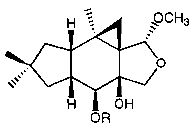Description
Pileus: 4-15 cm in diameter; convex–umbilicate to depressed or infundibuloform; smooth; dry; glabrous; dull white.
Flesh: thick, compact, white; taste extremely acrid.
Latex: white, unchanging.
Gills: subdecurrent, close, forked, white to creamy.
Stem: 1.5-5 cm long, 1-2 cm thick; equal or tapering downward; smooth; dry; solid; glabrous; white.
Spores: white; subglobose or subellipsoid; warted and reticulate, 6-8.5 x 5.5-6.5 µm.
Distribution: Europe, North America.
Found scattered to gregarious on ground in woods.
Edible with caution.
Synonyms
Agaricus piperatus L.
Lactarius pergamenus sensu auct.
Lactifluus piperatus (L.) Kuntze
Lactifluus piperatus (L.) Roussel
Common name
Peppery milkcap
Peppery milky
Pfeffermilchling (German)
Compounds
A new amino acid has been isolated from the peppery milkcap, named 2(S),3‘(S)-1-(3-amino-3-carboxypropyl) -5-oxo-2-pyrrolidinecarboxylic acid (Fushiya et al., 1987).
Four new marasmane sesquiterpenoids, lactapiperanols A-D, were isolated from the fruit bodies of Lactarius piperatus along with two known compounds lactarorufin and furosardonin (Yaoita et al., 1999b).
A) B)
B)
Novel marasmane sesquiterpenoids from L. piperatus. (a) lactapiperanols A (R=H) and B (R-Ac) (b) lactapiperanols C (R=H) and D (R=Ac).
Another groups of researchers (Wang et al., 2003) reported the discovery of four additional novel sesquiterpenes from the ethanol extract of L.piperatus:
- 7,8,13-trihydroxy-5,13-marasmanolide
- isoplorantinone
- 4,8,14-trihydroxyilludala-2,6,8-triene
- 8-hydroxy-8,9-secolactara-1,6-dien-5,13-olide
… as well as six previously known ones:
- 7 ,8 -dihydroxy-5,13-marasmanolide
- 7 ,8 -dihydroxy-5,13-marasmanolide
- isolactarorufin
- blennin A
- blennin D
- lactarorufin
A natural liquid rubber has been found to be a small constituent of L. piperatus latex, composed largely of repeating cis-isoprene units (Tanaka et al., 1994).
According to Jayko and associates (1974), a hot water extract of L. piperatus inhibits Lewis pulmonary adenoma in white mice, with an inhibition rate of 80% against Sarcoma 180, and 70% against Ehrlich carcinoma.

My name is Austin Collins.
I've dedicated my life to Mushrooms.
I believe Mushrooms are the best kept secret when it comes to health and well being.
For that reason, I would like to share a company with you that in my opinion makes the best mushroom products on the market.
The company is called Noomadic Herbals, my favorite supplement they make is called "Mushroom Total".
I take their products every day and they have helped me think better and have more energy. Give them a try.
-Austin
Chemical composition
Analysing L. piperatus for constituents such as moisture, fat, proteins, ash and carbohydrates, Barros et al. (2007a) showed that while protein and unsaturated fatty acid levels increased with the fruiting body maturity stage, the carbohydrate and saturated fatty acid content decreased. The maturity of the mushroom stage had little effect on individual sugar composition.
Methanol extracts from Lactarius piperatus have been investigated for antimicrobial activity. Using agar disk diffusion assays, L. piperatus revealed antimicrobial activity against Escherichia coli, Proteus vulgaris, and Mycobacterium smegmatis, but did not show any antagonistic effect against the yeast Candia albicans (Dulgar et al., 2002).
In another recent study (Barros et al., 2007a), the antimicrobial activity of the peppery milkcap was shown to correlate positively to the levels of phenols, flavonoids, ascorbic acid, β-carotene, and lycopene present in the immature and mature fruiting bodies. Mature fruiting bodies with mature spores had lower antimicrobial activity, agreeing with the bioactive compound content found in those samples (Barros et al., 2007a).
Similar in purpose to their antibacterial study discussed above, Barros and coworkers performed some interesting experiments to examine the effect of fruit body maturity on antioxidant levels and activity. A variety of standard biochemical assays were used to screen antioxidant activity, including:
- reducing power
- DPPH radical scavenging activity
- inhibition of oxidative hemolysis in erythrocytes induced by AAPH
- inhibition of lipid peroxidation by β-carotene-linoleate system.
Additionally, they determined the amounts of known antioxidants, such as polyphenols, flavonoids, ascorbic acid, β-carotene and lycopene present in the fruiting bodies at various stages of development. L. piperatus was found to have the highest antioxidative capacity in the mature stage of development, before the spores mature (Barros et al., 2007b). As they explain, this stage occurs when the caps are between 4.5-7cm broad.
Web
Mushroom expert is a good source of information.
A huge photo gallery of the peppery milkcap may be found here.
References
Barros L, Baptista P, Estevinho LM, Ferreira ICFR.
Effect of fruiting body maturity stage on chemical composition and antimicrobial activity of Lactarius sp. mushrooms.
J Agric Food Chem. 2007a 55(21):8766-8771.
Barros L, Baptista, P, Ferreira ICFR.
Effect of Lactarius piperatus fruiting body maturity stage on antioxidant activity measured by several biochemical assays.
Food Chem. Toxicol. 2007b 45:1731–1737.
Choi EC, Kim BK
Studies on the constituents of the higher fungi in Korea. Part 4. Isolation of gultorin from Lactarius piperatus.
Korean Journal of Pharmacognosy. 1975 (6)1:49-51.
Dulger, B, Yilmaz, F, Gucin, F.
Antimicrobial activity of some Lactarius species.
Pharm Biol. 2002 40(4):304-6.
Fushiya 1988 Fushiya, S, Watari, F, Tashiro, T, Kusano, G, Nozoe, S.
A new acidic amino-acid from a basidiomycetes, Lactarius piperatus.
Chem Pharm Bull. 1988 36(4):1366-70.
Jayko LG, Baker TI, Stubblefield RD, Anderson RF.
Nutrition and metabolic products of Lactarius species.
Canadian Journal of Microbiology. 1974 8:361–371.
Sterner, O.
Toxic terpenoids from higher fungi and their possible role in chemical defense systems.
Cryptogamie Mycologie. 1995 16(1):47-57.
Tanaka Y, Kawahara S, Eng AH, Takei A, Ohya N.
Structure of cis-polyisoprene from Lactarius mushrooms.
Acta Biochim Pol. 1994 41(3):303-9.
Wang Y, Yang SP, Yue JM, Chow S, Kitching W.
Novel sesquiterpenes from the fungus Lactarius piperatus.
Helvetica Chimica Acta. 2003 86(7):2424-33.
Yaoita Y, Endo M, Tani Y, Machida K, Amemiya K, Furumura K, Kikuchi M.
Studies on the constituents of mushrooms, part VI – Sterol constituents from seven mushrooms.
Chemical & Pharmaceutical Bulletin. 1999a 47(6):847-51.
Yaoita Y, Machida K, Kikuchi M.
Studies on the constituents of mushrooms, part V – Structures of new marasmane sesquiterpenoids from Lactarius piperatus (SCOP.: Fr.) S. F. Gray.
Chemical & Pharmaceutical Bulletin. 1999b 47(6):894-6.



